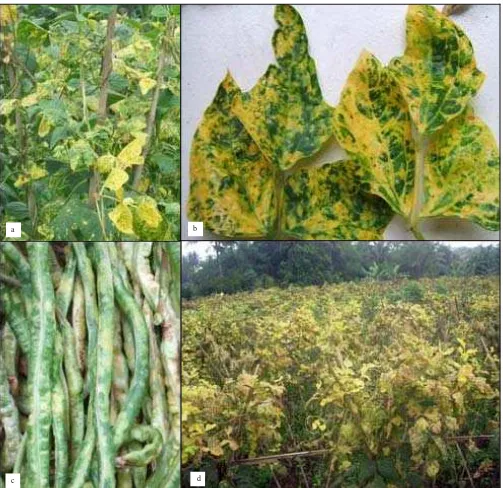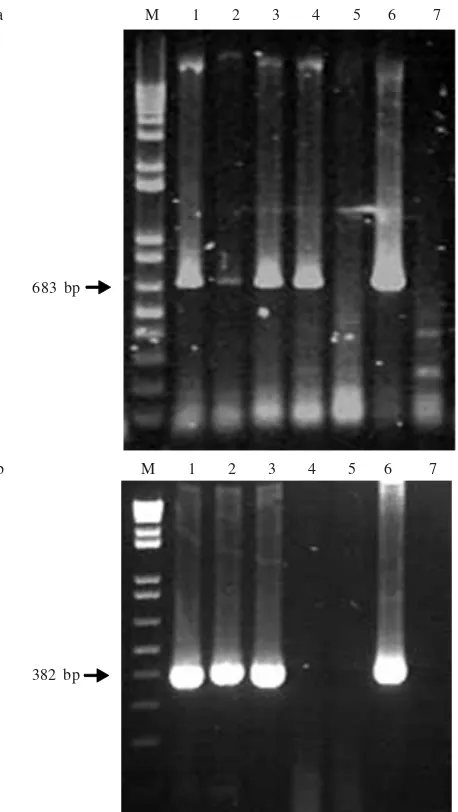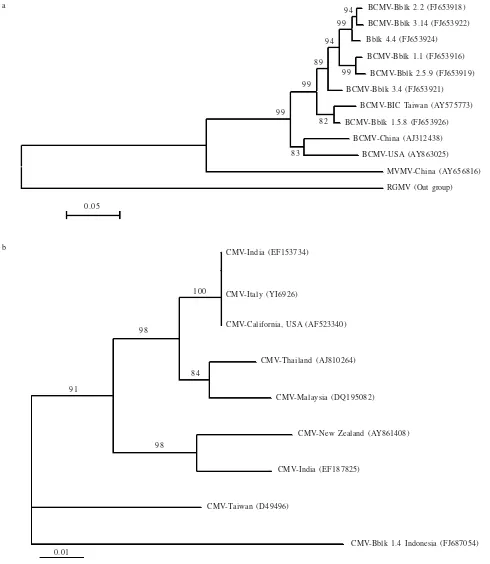ISSN: 1978-3019
SHORT COMMUNICATION
Severe Outbreak of a Yellow Mosaic Disease on the Yard Long Bean
in Bogor, West Java
TRI ASMIRA DAMAYANTI1∗∗∗∗∗, OLUFEMI JOSEPH ALABI2, RAYAPATI ADIKESAVULU NAIDU2, AUNU RAUF1
1Department of Plant Protection, Faculty of Agriculture, Bogor Agricultural University,
Darmaga Campus, Bogor 16680, Indonesia
2Department of Plant Pathology, Irrigated Agriculture Research and Extension Center, Washington State University,
24106 N Bunn Road Prosser, WA, USA
Received December 12, 2008/Accepted May 2, 2009
During 2008 crop season, an outbreak of severe yellow mosaic disease on yard long bean (Vigna unguiculata subsp. Sesquipedalis) occurred in several farmers’ fields in West Java. Yard long bean var. Parade inoculated manually with extracts from symptomatic leaves showed the symptoms indicating the presence of virus. Symptomatic leaf samples tested positive in enzyme linked immunosorbent assay (ELISA) with antibodies to group specific Potyvirus and Cucumber mosaic virus (CMV). Total RNA derived from symptomatic leaves was subjected to reverse transcription-polymerase chain reaction (RT-PCR) using primers specific to the cylindrical inclusion (CI) protein of potyviruses and CMV coat protein (CP) specific primers. Pair wise comparison of sequences obtained from cloned RT-PCR products with corresponding nucleotide sequences in the GenBank confirmed the presence of Bean common mosaic virus strain Blackeye (BCMV-BlC) and CMV in the symptomatic beans. Sequences of BCMV and CMV isolates from the beans showed maximum nucleotide sequence identities (92-97%) and (90%), respectively with BCMV-BIC and CMV isolates from Taiwan. Each virus isolate also clustered closely with corresponding isolates from Taiwan in a phylogenetic analyses. These results provide first evidence of the occurrence of multiple infection of BCMV-BIC and CMV in the yard long been from Bogor, West Java.
Key words: yard long bean, BCMV-BIC, CMV, Bogor Indonesia
___________________________________________________________________________
∗Corresponding author. Phone: +62-251-8629364, Fax: +62-251-8629362, E-mail: triadys@yahoo.com
INTRODUCTION
Yard long bean (Asparagus bean; Vigna unguiculata
subsp. Sesquipedalis) is a legume extensively cultivated in Indonesia consumed as a green vegetable. Yard long bean, a native of Southeast Asia bean, known as “kacang panjang” in Indonesia, produces delicious edible pods and beans that are popular for their delicate flavor and nutritional value. Since the middle of 2008, a severe virus-like disease outbreak with yellow mosaic symptoms was observed in the beans grown in farmers’ fields in West Java (Bogor, Bekasi, Indramayu and Cirebon) (Damayanti, Wiyono and Rauf, field observations). Indonesian Department of Agriculture also announced that the similar symptom was observed in Tangerang Banten, Subang, and Muntilan, (Central Java). In the fields, the leaves of symptomatic plants showed severe mosaic with bright yellow and vein-clearing symptoms and the pods produced by these plants were deformed with mosaic symptoms on the surface (Figure 1a-d). Vein-clearing also was observed conferring a netting pattern on the symptomatic leaves. As the season advanced, the leaves showed bright yellow mosaic symptoms followed by necrosis and the death of infected
plants. In Bogor area, the disease was observed on yard long bean. The disease spread rapidly in the fields with incidence up to 80-100% resulting in huge crop loss.
The aim of the research is to identify the causal of a yellow mosaic disease on yard long bean in Bogor, West Java.
MATERIALS AND METHODS
Serological Test. To investigate the causal agent(s) of disease, we collected symptomatic leaves from field in Bubulak, Bogor. The serological and transmission tests were conducted in Laboratory of Plant Virology, Department of Plant Protection, Bogor Agricultural University (BAU), Bogor, while the molecular detection, cloning, and sequencing were done at Washington State University (WSU), Prosser, WA, USA. Samples were tested with enzyme linked immunosorbent assay (ELISA) using antibodies against viruses infecting legumes such as Potyvirus genus-specific antibodies (AS-573/1; DSMZ, German Resource Center for Biological Material, Braunschweig, Germany) and antibodies raised against specific potyviruses such as Bean yellow mosaic virus
tested with ELISA using antisera (AS-0929) raised against
Cucumber mosaic virus (CMV; genus Cucumovirus). Mechanical Transmission. Symptomatic leaves with severe yellow mosaic symptoms were homogenized in 0.1 M phosphate buffer (pH 7.2) containing 1% â-Mercaptoethanol (1:10, w/v) and inoculated onto primary leaves of 10 days old healthy yard long bean cv. Parade plants (Panah Merah). The inoculated plants were maintained in an insect-proof net house for symptom development.
Molecular Detection. Similar samples of symptomatic yard long bean leaves used in ELISA test were pressed on FTA
classic cards (FTA® Classic Card, Whatman International Ltd.,
UK) and shipped to Washington State University under the USDA-APHIS-PPQ permit number P526P-07-06707. Viral nucleic acids were recovered from 3 mm diameter FTA card
discs (four discs per sample) into extraction buffer (Alabi et
al. 2008). One tube-single step RT-PCR was carried out using
degenerate potyvirus-specific cylindrical inclusion (CI) primers (CIFor: 5’-GGIVVIGTIGGIWSIGGIAARTCIAC-3’ and
CIRev: 5’-ACICCRTTYTCDATDATRTTIGTIGC-3’) (Ha et al.
2008) and degenerate primers (CMV-1F: 5’-ACCGCGGGT CTTATTATGGT-3’ and CMV-1R: 5’ ACGGATTCAAA CTGGGAGCA-3’) specific for CMV coat protein (CP)
subgroup I (Aramburu et al. 2007).
Figure 1. Symptoms of yellow mosaic disease in yard long beans. Trifoliate leaves of infected plants showed severe yellow mosaic symptoms (a and b), the pods produced by infected plants showed deformations and mosaic (c), and severe infection in the field (d).
b
d c
Cloning and DNA Sequencing. The amplified DNA fragments were cloned separately into pCR2.1 vector (Invitrogen Corp., Carlsbad, CA) according to manufacturer’s instructions. Two independent clones per amplicon were sequenced from both orientations.
Phylogenetic Analysis. The nucleotide sequences of the CI and the partial CMV CP genes were aligned independently with those of other BCMV and CMV and the phylogenetic tree were constructed from Clustal W-aligned sequences using
the program MEGA 4.0 (Tamura et al. 2007) with
neighbor-joining method and maximum composite likelihood model to estimate the distances, and bootstrap support was estimated with 1,000 replicates.
RESULTS
ELISA Test. The symptomatic, but not healthy, samples tested positive using Potyvirus genus-specific and CMV-specific antisera, but were negative for BYMV, BCMV strain peanut stripe, SMV and CaBMV. These results indicate the presence of CMV and a yet to be identified Potyvirus in symptomatic samples.
Transmission. Chlorosis of inoculated leaves were observed 5-7 days post-inoculation, while newly developing trifoliate leaves showed mosaic symptoms with green vein-banding. These leaves showed bright chlorosis about 4 weeks post-inoculation. It is suggested that the yellow mosaic disease could be transmitted mechanically. On indicator plant
Chenopodium amaranticolor, the inoculated leaves produced two types of symptoms, necrotic lesions and chlorotic spots with reddish necrotic center of a pin head size. In ELISA test of symptomatic C. amaranticolor, the former type of symptoms tested positive for Potyvirus group-specific antibodies and the latter type of symptoms tested positive for CMV.
RT-PCR. Molecular detection by RT-PCRa 683 base pair (bp) fragment was amplified from four out of five samples with potyvirus-specific primers (Figure 2a), and a 382 bp fragment was amplified from three out of five samples with CMV-specific primers (Figure 2b). These results indicate the
presence of a Potyvirus and CMV as multiple virus infection
in three samples and presence of a Potyvirus as a single virus
infection in one sample. The severe symptoms observed in yard long bean plants somewhat resembled those induced
by Geminivirus and Luteovirus. The possibility of both groups
virus co-infecting these yard long bean plants were tested by
PCR using universal primers for Geminivirus as described by
Deng et al. (1994), and Luteovirus (Zhi-qiang et al. 2000).
This possibility, however, was ruled out based on results obtained (data not shown).
Phylogenetic Analysis. Pair wise comparison of these sequences with corresponding nucleotide sequences in the GenBank showed 92-97% with BCMV strain Blackeye
(BCMV-BlC; formerly known as Blackeye cowpea mosaic virus
-BlCMV) sequences from Taiwan (GenBank accession numbers AY575773) and 88-90% with BCMV sequences from China
(AJ312438) and USA (AY863025) in the CI region. BCMV isolates from Indonesia clustered with BCMV isolate from Taiwan, suggesting that Indonesian isolates are more closely related to BCMV from Taiwan and distantly related to those from China and USA (Figure 3a). The CMV isolates from yard long bean showed 100 percent identity among themselves. The CMV isolate (FJ687054) showed 90% more closely with CMV sequences from Taiwan, India, Italy and California rather than CMV from New Zealand (88%), Thailand (88%), and Malaysia (89%) and clustered with CMV from Taiwan (Figure 3b). These results confirmed the occurrence of multiple infections of BCMV-BlC and CMV in symptomatic leaves of yard long bean.
a M 1 2 3 4 5 6 7
b M 1 2 3 4 5 6 7 683 bp
382 bp
BCMV-Bblk 2.2 (FJ653918) BCMV-Bblk 3.14 (FJ653922) Bblk 4.4 (FJ653924)
BCMV-Bblk 1.1 (FJ653916) BCMV-Bblk 2.5.9 (FJ653919) BCMV-Bblk 3.4 (FJ653921)
BCMV-BIC Taiwan (AY575773) BCMV-Bblk 1.5.8 (FJ653926)
BCMV-China (AJ312438) BCMV-USA (AY863025)
MVMV-China (AY656816) RGMV (Out group) 9 4
9 9 9 4 8 9 9 9
9 9
8 3 8 2
9 9
0.05 a
Figure 3. Phylogeny of the CI gene of BCMV (a) and the CP gene of CMV (b) isolates from yard long bean obtained from Bubulak (Bblk) Bogor, West Java. The isolates are highlighted in gray. The tree were inferred by the Neighbor-Joining method using molecular evolutionary genetics analysis (MEGA) software version 4.0 based on the Clustal W alignment of BCMV sequences from Indonesia, Taiwan, China, and USA. The tree was rooted using Wisteria vein mosaic virus (WVMV) and Rye grass mosaic virus (RGMV) as out groups. The CMV sequences was aligned with CMV isolate from India, Malaysia, Thailand, Taiwan, California, New Zealand, and Italy (b). Bootstrap values expressed as a percentage of 1,000 replicates, that are greater than 70 are shown on tree branches. The bar at the bottom left represents 0.05 and 0.01 nucleotide changes per site.
CMV-India (EF153734)
CMV-Italy (YI6926)
CMV-California, USA (AF523340)
CMV-Thailand (AJ810264)
CMV-Malaysia (DQ195082)
CMV-New Zealand (AY861408)
CMV-India (EF187825)
CMV-Taiwan (D49496)
CMV-Bblk 1.4 Indonesia (FJ687054) 0.01
b
1 0 0
9 8
9 1
8 4
DISCUSSION
BCMV (genus Potyvirus, family Potyviridae) and CMV (genus Cucumovirus, family Bromoviridae) have broad host range and are widely distributed around the world (Shukla & Brunt 1994; CABI 2005). Their occurrence as dual infection has been reported in Georgia on V. unguiculata subsp.
unguiculata and in Taiwan on asparagus bean. Both viruses caused synergistic interactions resulting in increased symptoms severity in mixed infected plants than those that are singly infected (Gillaspie et al. 1998; Chang et al. 2002). Previously, both BCMV and CMV have been documented in soybean, mung-bean, and groundnut in East Java of Indonesia (Green et al. 1988) and caused single infection of those plants. BCMV-BlC, but not CMV, also was documented on yard long beans in Guam (Wall et al. 1996). Thus, our study represents the first report of the occurrence of multiple infections of BCMV-BlC and CMV in yard long beans in Bogor. It is plausible that such mixed virus infections are also present in yard long bean fields in other places in Java, Indonesia. However, further investigation is needed to determine the etiology of yellow mosaic disease in these locations.
BCMV and CMV are known to be seed-borne in many legumes, including yard long bean, and transmitted by several species of aphids, including Aphis craccivora Koch, in a non-persistent manner (Shukla & Brunt 1994; Wall et al.1996; Gillaspie et al. 1998; Roossinck 2001; CABI 2005; Schwartz et al. 2005). We have observed A. craccivora in yard long beans and other legumes in Indonesia. It is likely that this species of aphid played a role in the spread of BCMV and CMV. Hence, further studies on the causal of yellow mosaic disease from other places in Java island, the role of aphid vector, seed transmission and alternative hosts of these viruses are in progress to gain a comprehensive understanding of the epidemiology of yellow mosaic disease in yard long bean. It is hoped that the outcome of these studies will help in the development of disease management strategies to mitigate the negative impacts of BCMV and CMV for sustainable production of yard long beans in Indonesia.
ACKNOWLEDGEMENT
This research was partially funded by the International Strategies Research Activity IPB (PUI 2009) with contract No.
44/I3.24.4/SPK/BG-PSN/2009 to TAD and the Office of Natural Resources Management within the Bureau for Economic Growth, Agriculture, and Trade (EGAT) of the U.S. Agency for International Development (USAID), under the terms of the Integrated Pest Management Collaborative Research Support Program (IPM-CRSP), award no. EPP-A-00-04-00016-00) to RAN.
REFERENCES
Alabi OJ, Kumar PL, Naidu RA. 2008. Multiplex PCR for the detection of African cassava mosaic virus and East African cassava mosaic Cameroon virus in cassava. J Virol Methods 154:111-120. Aramburu J, Galipienso L, Lopez C. 2007. Reappearance of Cucumber
mosaic virus isolates belonging to subgroup IB in Tomato Plants in North-Eastern Spain. J Phytopath 155:513-518.
[CABI] Centre for Agriculture and Biosciences International. 2005. Crop Protection Compendium. (Serial Online). CAB International. Chang CA, Chen CC, Yang TT, Tsan TM. 2002. Research development, extension and prospects of applying virus-free seed for the control of virus diseases of asparagus beans in Taiwan.
Plant Prot Bull 11:107-111.
Deng D, Mcgrath PF, Robinson DJ, Harrison BD. 1994. Detection and differentiation of whitefly-transmitted geminiviruses in plants and vector insects by the polymerase chain reaction with degenerate primers. Annals Appl Biology 125:327-336.
Gillaspie AG, Hajimorad MR, Ghabrial SA. 1998. Characterization of a severe strain of Cucumber mosaicCucumovirus seedborne in cowpea. Plant Disease 82:419-422.
Green SK, Lee DR, Horne NM. 1988. Survey for viruses of soyabean, mung bean and peanut in Java, Indonesia. Plant Disease 72:994. Ha C et al. 2008. Design and application of two novel degenerate primer pairs for detection and complete genomic characterization of potyviruses. Arch Virol 153:25-36.
Roossinck MJ. 2001. Cucumber mosaic virus, a model for RNA virus evolution. Mol Plant Pathol 2:59-63.
Schwartz HF, Steadman JR, Hall R, Forster RL. 2005. Compendium of Bean Diseases. 2nd ed. APS Pr.
Shukla DD, Brunt AA. 1994. The Potyviridae. CAB International, UK.
Tamura K, Dudley J, Nei M, Kumar S. 2007. MEGA 4: Molecular evolutionary genetics analysis (MEGA), version 4.0. Mol Biol Evol 24:1596-1599.
Wall GC, Kimmons CA, Weick AT, Richardson J. 1996. Blackeye cowpea mosaic virus (BlCMV) in yard-long bean in the Mariana Islands. Micronesica 29:101-111.


